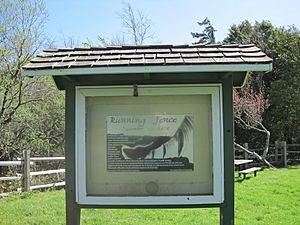Running Fence facts for kids
Quick facts for kids Running Fence |
|
|---|---|
 |
|
| Artist | Christo and Jeanne-Claude |
| Year | September 10, 1976 |
| Type | Installation art |
Running Fence was a huge art project by two artists named Christo and Jeanne-Claude. They finished it on September 10, 1976. This amazing art piece took over four years to plan and build. But here's the cool part: it only stayed up for 14 days! After that, it was completely taken down, leaving no trace behind.
Contents
What Was the Running Fence?
The Running Fence was a long, flowing fence made of white fabric. It stretched for about 24.5 miles (39.4 kilometers) across the hills. This giant fence went through Sonoma and Marin counties in northern California, United States.
How Was the Running Fence Built?
The fence stood about 18 feet (5.5 meters) tall. It was made from 200,000 square meters (2,222,222 square feet) of strong white nylon fabric. This fabric was shaped into 2,050 large panels. These panels hung from steel cables using 350,000 hooks.
The cables were held up by 2,050 steel poles. Each pole was about 21 feet (6.4 meters) long. They were pushed 3 feet (1 meter) into the ground. Strong steel wires, about 90 miles (145 kilometers) long, helped brace the poles. The artists also used 14,000 earth anchors to keep everything steady. No concrete was used to hold it in place!
Planning and Costs
The fence started near U.S. Highway 101. It crossed 14 roads and the private land of 59 ranchers. It finally reached the Pacific Ocean near Bodega Bay.
This art project needed a lot of teamwork and planning. It took 42 months of hard work. There were 18 public meetings and 3 court sessions to get permission. The artists paid for the entire project themselves. They did this by selling their other artworks. These included drawings, models, and prints.
Some people say the idea for the Running Fence came from fences. These fences marked the Continental Divide in Colorado.
The Legacy of Running Fence
Even though the Running Fence was temporary, it left a lasting mark.
Commemorative Markers
You can find special markers that remember the project. One is at Watson School near Bodega, California. Another is on State Route 1 in Valley Ford, California. In December 1976, the Valley Ford site was even named a History Landmark.
Remaining Pieces
The largest part of the Running Fence that is still together hangs in the Rio Theater. This theater is in Monte Rio, California. It hangs from the ceiling there.
Museum Exhibition
From April to September 2010, there was a special art show. It was called Christo and Jeanne-Claude: Remembering the Running Fence. This show was at the Smithsonian American Art Museum. Visitors could see over 350 items from the project. They could even touch the actual fabric and steel poles used in the fence!
The Running Fence Documentary
The Running Fence was featured in a 1978 movie. It was a documentary film also called Running Fence. The film was made by Albert and David Maysles.
The movie shows how local people reacted to the project. Some people were very excited about it. Others were not happy and protested against it. For example, painter Byron Randall protested because he felt it took over the land. He also thought it wasn't good art. But many others loved the beauty of the artwork. In the end, the project was successfully completed.
Gallery
-
Sign at Watson School



